Heading out the door? Read this article on the new Outside+ app available now on iOS devices for members! Download the app.
In the last century, the climbing hardware category has come so far technically that groundbreaking innovations—like Friends, in the 1970s—are rare. Still, climbing hardware continues to evolve, from refinements on classic gear like belay devices, to more-ergonomic iterations of staples like quickdraws, to more compact and lighter designs. Below, you’ll find the best climbing hardware available in 2024.
At a Glance
- Editor’s Choice: Metolius Roll Up Stick Clip Kit ($225)
- Black Diamond Sewn Anchor System ($35)
- Edelrid Ohm II Assisted Braking Device ($150)
- Fixe Hardware Alien X Cam ($85)
- Ocun Raven Quickdraw Zoom (from $29)
- Petzl Grigri Belay Device ($110)
- Trango Physic Pink Screwlock ($14)
- Wild Country Electron Sport Draw ($135 for a 6-pack)
- How Important Is Weight?
- How We Test
- Meet Our Lead Testers
All gear in this guide was tested by multiple reviewers. When you buy through our links, we may earn an affiliate commission. This supports our mission to get more people active and outside. Learn more.
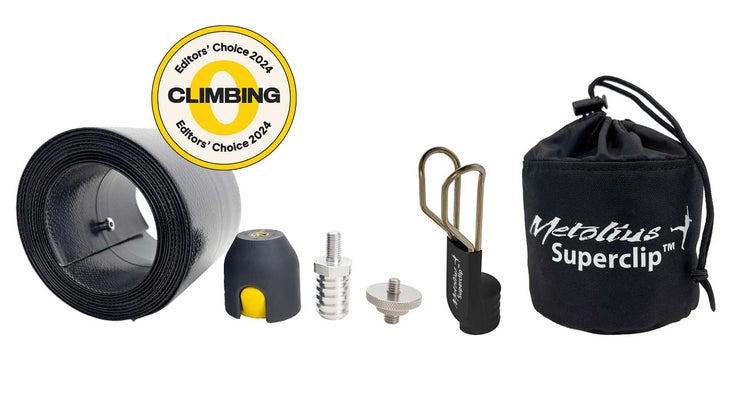
Editor’s Choice: Metolius Climbing Roll Up Stick Clip Kit
$225 at REI $225 at Backcountry
Weight: 28 oz (full kit); 21 oz (pole only)
Dimensions: Kit in bag is 3.75” x 4.5”; stick extends to 9.8 feet
Pros and Cons
⊕ Travel-friendly
⊕ Durable components
⊗ Stick can be wobbly at full extension
⊗ Rolling the stick back up takes elbow grease
Last year, I flew out to the Red River Gorge, Kentucky, with a telescoping, sub-9-foot-long stick clip, which just barely fit in my pack and, to my dismay, was a hair too short for many first bolts. This year, I flew back out with the Roll Up Stick Clip, which extends to 9.8 feet but packs down to the size of a large can of tomato sauce.
Its compact design comes courtesy of a space-age composite material that comes tightly rolled in a cylinder. Like a Fruit Roll-Up, it unfurls and refolds into a tube that you can click the end fitting into. (The fitting accepts an included Superclip or camera-mount adapter.) I was initially skeptical about durability, but after unrolling and re-rolling it dozens of times and banging the stick around at the crags, it’s remained as solid as on day one, with no cracking or deformation, though another tester, Iowa-based climber and writer Mary Andino, noted some minor fraying on the ends.
Tester and Climbing editor Delaney Miller, who used the stick at Colorado’s Rifle Mountain Park, felt it was too short for certain climbs. (At roadside areas like Rifle, your best bet is probably a giant painter’s pole anyway.) Testers also noted that it takes elbow grease to roll the stick back up, an issue obviated by wearing belay gloves and jamming the end against the ground. Also, you may need pliers to get the thread adaptor on and off if swapping in a camera.
Still, if you’re flying to your climbing destination, there’s no better option than this innovative option from Metolius. The only thing missing from this stick: A hook on the adapter head for pulling down the rope as it slides through the draws.
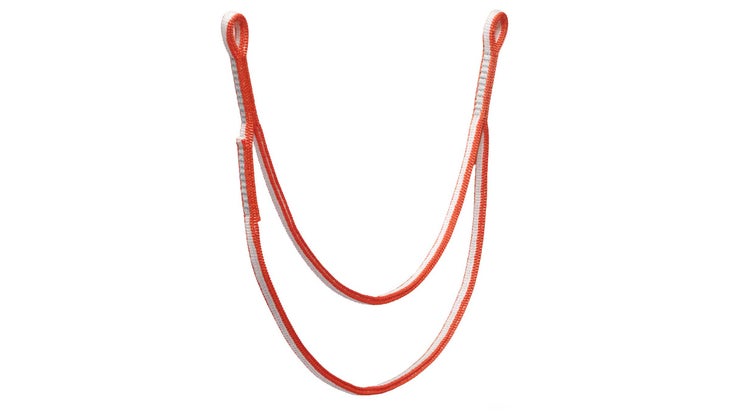
Black Diamond Sewn Anchor System
$35 at REI $35 at Black Diamond
Weight: 1.6 oz
Dimensions: 10mm thick webbing; longest leg of anchor between clip-in eyes is 22”
Pros and Cons
⊕ Ideal for those new to multi-pitch anchor-building
⊕ Intuitive and strong (22kn)
⊗ A little awkward to carry
The Sewn Anchor System is one of those things you probably didn’t know you needed until it existed—a self-equalizing, self-adjusting anchor system for two-bolt (or two ice-screw) belays on multi-pitch climbs. While using slings or a cordelette/quadelette always worked in the past, things could get tangled or confused at the belay, and cordelettes are bulky on the harness. The Sewn Anchor System does what a quad would do, offering two self-equalizing legs to clip into, one riding higher than the other, but using ultralight Dyneema that creates minimal bulk and streamlines anchor carry.
It was also extremely intuitive: there are two offset bartacked clip-in eyes for the bolt carabiners, and once you’ve clipped those, the two legs are good to go—clean, accessible, and right there in front of you. I clove-hitched myself off to the lower leg and belayed off the upper, and it worked perfectly, with plenty of room on either leg for a partner to clip in at the belay. A buddy who’s an experienced climber but a novice on multi-pitch climbs was put at ease by the idiot-proof design. We were only able to find one pitfall: bolt failure when clipping a locker around both legs—something you should generally avoid.
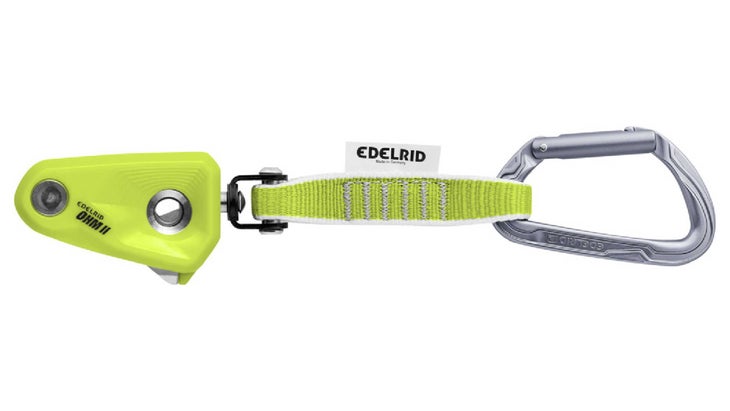
Edelrid Ohm II Assisted Braking Device
Weight: 15.9 oz
Rope diameter: 8.9 – 11 mm
Pros and Cons
⊕ New swivel joint makes for better handling
⊕ Intuitive to set up and use
⊕ Smaller than previous iteration
⊗ Leader needs to pull slack smoothly, jerking can lock up the device
Back in the day we used the term “clackerballs” or “clackers” to describe when a heavier climber fell low on a route, pulled their belayer up to the first bolt, and then collided midair like a clacker ringing a bell. In 2017, Edelrid released its assisted-brake resistor, the Ohm, which the climber clips to the first bolt as a friction assist/redirect, adding friction to the system to mitigate, that scenario. It was a game-changer, doing away with the need for the lighter belayer to clip themselves to the floor or something weighty, like a sandbag. It was also unidirectional in terms of rope flow and imparted a lot of friction.
The new, less bulky Ohm II adds a swivel joint that lets the device rotate, which led to better handling overall, according to diehard Rifle, Colorado, sport climber Lucie Hanes. “This version seems much more fluid than the previous, [and] looks and functions more smoothly and simply.” As a smaller climber, Hanes is accustomed to being yanked into the air by her heavier partner, but she never once left the ground while using the Ohm. She also noted reliable lowering and clipping action. “The Ohm II was particularly helpful when my partner was working on a roof route that would cause him to boink excessively after falling,” added Hanes.” I could give him a tighter catch and prevent such a big fall.”
She commented that the friction felt a bit intense. For scenarios in which you want to give a softer or longer catch—such as dropping your climber past an obstacle or jumping at the end of the fall—you are giving up total control, meaning the Ohm II may not be ideal for all belaying situations..

Fixe Hardware Alien X Cam
Weight: 1.9 oz (size 1/3) to 2.5 oz (size 1)
Dimensions: Full set of cams protects from 0.38″ to 1.31″
Pros and Cons
⊕ Smooth, finger-friendly trigger action
⊕ Full set of 6 weighs only 13.1 oz
⊕ Three biggest sizes work as passive pro
⊗ Softer stems contributed to cams walking
⊗ Largest size (1—the red cam) started to deform along its stem
The Alien X cams are cutting-edge, hi-tech seam and thin-crack pro for climbers focused on quick placements and light weight, making them ideal for hard gear-protected leads, techy multi-pitch, and alpine rock.
Aliens were originally made by Colorado Custom Hardware and, with their flexible stems and narrow heads, were ideal for the pin scars and tight seams of Eldorado Canyon’s sandstone, where they gained a cult following. (I still occasionally use my OG black Alien there.) Fitting, then, that much of our testing took place back in Eldo, as well as on local Colorado granite.
Tester and local guide Becca Droz appreciated the Alien Xs’ buttery trigger action—maybe the smoothest pull of any micro-cam I’ve used. “Initially, I noticed how easily the lobes moved at the pull of the triggers; it felt like little resistance,” agreed Droz. The subtly milled “X-grip” texture on the cam lobes gave them great grabbing power on slick sandstone and smooth granite.
Plus, the cams are barely noticeable weight-wise on the harness or in hand—they place quickly, with minimal exertion. On the flip side, the ultralight components, including the stem, made the Alien X a little prone to wiggling, especially at the larger sizes; that wiggle, noted Droz, contributed to the No. 1 sometimes walking its way into the crack, and she stopped bringing it on guided outings because her clients had trouble removing it. That said, this newest generation has many welcome upgrades, including recessed trigger wires, color-coded lobes, and a longer sling. As with previous Aliens, the Xs also cover size gaps (looking at you, green [1/2] and yellow [3/4]) not addressed by other brands.
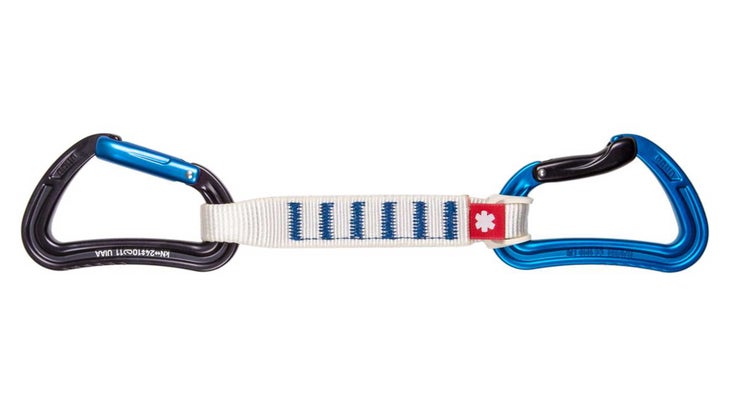
Ocun Raven Quickdraw Zoom PA
Weight: 3.7 oz (12cm), 3.9 oz (16cm)
Dimensions: Gate opening is 23 mm on both the straight- and bent-gate carabiners; carabiners are 100 mm x 63 mm
Pros and Cons
⊕ Ample spine and plus-sized basket feel roomy
⊕ Tapered, variable width dogbones are thick for easy grabbing
⊕ Gate action is snappy but not stiff
⊗ Not ultralight
Quickdraws are so basic and universal in function that they’re tough to review. But when you find yourself repeatedly going with one draw on a crux clip—as I did with the Raven Quickdraw Zoom PA on Transworld Depravity (5.14a) at the Red River Gorge—then you know you have a winner.
Fellow tester and Climbing editor, Anthony Walsh, appreciated the carabiners’ remarkable roominess: Both the straight and bent gates have mondo baskets, with an acute angle that holds them firmly in place. This design, coupled with a depth-reducing I-beam construction, gave them a reassuring feel. “Hanging the Raven was a treat thanks to the subtle thumb-catch indents on either side of the rock-side carabiner gates,” said Walsh. “Clipping was stress-free, too, because of the generous bend in the rope-side carabiner gate.”
He also appreciated the snappy gate action while onsighting at steep areas like the Red River Gorge, Kentucky, and Rifle, Colorado; Walsh surmised that a lesser, stickier clipper would have spelled big-whip disaster when he was “bricked”—i.e., pumped stupid—on these climbs. We’ve also both noted how well the draws are wearing: After months of battering, they still clip smooth and look good, with their flashy white/blue and white/pink colorways as vibrant as new.

Petzl Grigri Belay Device
$110 at REI $110 at Backcountry
Weight: 6.2 oz
Dimensions: 4” x 2” x 1.5”
Rope diameter: 8.5 mm to 11 mm
Pros and Cons
⊕ Flowy rope-feeding action
⊕ Compact size feels natural in the palm
⊕ Belay-assist camming action is clutch for long belays
⊗ Enclosed rope channel is a dirt magnet
The Grigri is far from new—the original iteration came out in 1991. Dear mother bought me the OG when I told her it would “make me safer on the rocks.”The Grigri has since gone through several iterations. The latest version, which came out in 2018, is still a brilliantly realized version of the classic cam-assisted belay device.
It feeds as silky-smooth as I remember, especially with skinnier ropes (sub-10 millimeters), and locks up reliably and in a timely fashion when catching big whips, letting me jump into falls with confidence. I tested this repeatedly at the Red River Gorge, catching friends who’d climbed up into trouble, level with the next clip, but then were too pumped to pull up rope.
The Grigri’s small size feels perfect in-hand, the lowering lever is well-balanced and easy to control, and, as ever, it can take a beating. The only drawback, as with all versions of the Grigri, is that the closed rope channel accumulates dirt and sand and needs to be scrubbed occasionally

Trango Physic Pink Screwlock
Weight: 2.8oz
Dimensions: Gate opening is 20 mm; basket is 45 mm; carabiner measures 105 x 67 mm
Pros and Cons
⊕ Responsive gate action
⊕ Easy-to-spin screwlock
⊕ High-functioning HMS locker in a compact size
⊗ Tight gate opening causes mild finger/thumb snagging
Yes, Munter hitches kink the unholy hell out of your rope, but there is a time and place for them—like when you’re rappelling after dropping your device or in complex guiding and rescue scenarios that use the Munter mule. Which is why we have the pear-shaped HMS (short for the German Halbmastwurfsicherung) lockers with big baskets to accommodate this half clove hitch while handling standard locker duties like belaying and masterpoints.
Usually, however, HMS carabiners are behemoths, adding weight and clutter on multi-pitch climbs. The Physic delivered solid HMS functionality in a welcome small, lightweight (2.8 oz) package that still felt beefy enough for the big jobs like anchoring and belaying.
The 45-millimeter basket was plenty large for both Munter and clove hitches to run smoothly or tighten down as needed, without the rope hanging up on the gate. And even when flipped—with the knot in the small basket—there was room for a clove or a Munter (though the latter, in motion, did creep up on the gate hinge). The gate action is responsive if not a bit stiff, which will probably only be an issue if you—like me—have big digits and fumble with micro-gear. I used the Physic at a masterpoint for rapping in to bolt a new climb, and, the next day, as the locker for my Grigri while cragging on the new line. In both cases, it performed admirably.
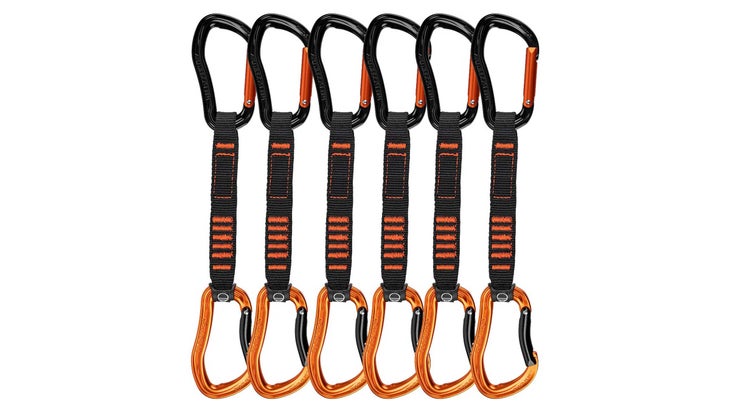
Wild Country Electron Sport Draw 12 cm
$135 at Backcountry (6-pack) $135 at Amazon (6-pack)
Weight: 3.8 oz per draw
Dimensions: Straight gate has 22mm opening; bent gate has 24mm opening
Pros and Cons
⊕ Responsive gate action
⊕ Innovative color coding
⊕ Ergonomic clipping
⊗ Can get sticky after dirt infiltrates the hinge
Wild Country has long been known for its innovative equipment: the brand was the first to manufacture and sell spring-loaded camming devices—its Friends—back in the late 1970s. Its Electron Sport Draw has the company’s trademark focus on craft, and while a little pricey, is well worth the money.
It’s a rapid-clipping, aesthetically pleasing, ergonomic draw that’s equally at home on send burns as it is during dogging sessions. I used them both for onsighting at the Red River Gorge and for a local redpoint/project in my backyard of Boulder, Colorado’s Flatirons. At the Red, I used an Electron to thwack away giant spiderwebs spun across a body-sized hueco, and then, totally pumped from my exertions, desperately tagged my draw onto the bolt and slapped the rope in.
Both the straight- and bent-gate carabiners have an elongated shape that was easy to maneuver and that clipped in a flash. For dogging sessions on my local, spider-free Colorado project, I dug the thick, tapered dogbone and those elongated, hand-swallowing carabiners, which made for palm-friendly shiny metal handholds.
Neither carabiner has a thumb notch, but I barely noticed. I did, however, note the pre-forged groove in each clipper’s basket: it helps the draws and rope stay put, but I worry about how it will contribute to long-term wear, especially at sandy areas like the Red that grit up your rope.
How Important Is Weight?
For climbers, the primary consideration with hardware is almost always weight. You have to schlepp the gear to the cliff, and then clip it to your harness or carry it in a multi-pitch pack. Manufacturers seem to be constantly on the hunt for ways to lighten their gear; in fact, they’ll sometimes offer a regular and an ultralight version of the same product.
What buyers sometimes fail to consider, however, is that lighter doesn’t by default equal better; it just equals better in certain situations, typically for alpine climbing, multi-pitch climbing, or onsight cragging where you’re placing pro or hanging draws. And there’s the physical reality that lighter gear—hollowed-out or drilled-out metal, thinner-diameter slings and ropes, smaller pulleys and belay devices, etc.—will be less resistant to wear-and-tear, thus prone to wearing out more quickly or even, under extreme forces, failure. In certain cases (front-country cragging where weight doesn’t matter as much, or with repetitive gear usage as with rigging, bolting, and guiding), beefier gear that’s more resistant to friction may work better and usually only adds a pound or two of weight in your pack.
How We Test
- Number of testers: 6
- Number of products tested: 14
- Total number of vertical feet: 38,160
- Total number of years climbing: 84
- Least punishing testing venue: Rifle Mountain Park, Colorado—cragside parking!
- Most punishing testing venue: Eldorado Canyon, Colorado, where even the moderates are heads-up
- Worst weather: Multiple days in a row of pounding rain—enough to make the holds “sweat” with condensation—at the Red River Gorge, Kentucky
We tested 14 products, then narrowed down our final selection to eight finalists. Our six testers put each piece of gear through its paces in as many venues as possible, including the climbing gym; front-country cragging in Boulder Canyon, Colorado; the sandstone of Colorado’s Flatirons and Eldorado Canyon; multi-pitch routes in the mountains of British Columbia; and the sandstone steeps of the Red River Gorge, Kentucky, and Jackson Falls, Illinois. Our testers ranged in age from their late 20s to early 50s, all with years if not decades of climbing experience.
The goal, with any hardware, is to test it against the manufacturer’s intended usage. For example, we sent the Fixe Hardware Alien X cams, built for thin cracks and seams, to seam-ridden Eldorado Canyon with the hard-working guide and Eldo maven Becca Droz. Being primarily a sport climber and new-router myself, I tested things like quickdraws, belay-assist devices, and stick clips while putting up or trying to redpoint routes. Although we considered factors like weight and appearance, the main criteria were always functionality, reliability, and durability: How well does this gear do what it’s supposed to do? And: Does it hold up over weeks and months of hardcore use, justifying the price?
Meet Our Lead Testers
Matt Samet, a freelance writer and editor, has been an avid rock climber since the mid-1980s, the era of high-top rock shoes, Hexentrics, and early-gen camming devices. He lives in Boulder, Colorado, where he primarily sport climbs, boulders, and trains in the gym and on his garage wall. He has been testing climbing gear for the past 20-plus years.
Boulder-based climber Becca Droz was another key tester. She, along with Kate Kelleghan, holds the women’s speed record on Eldorado Canyon’s Naked Edge (5.11b; 5 pitches). The pair set a blistering-fast time of 37:40 in September 2021. The feat encompasses a “bridge-to-bridge” effort: starting at the footbridge over South Boulder Creek, sprinting to and “scrambling” (5.8 free soloing) up to the route, simul-climbing the Edge, then sprint-downclimbing the exposed East Slabs descent back to the bridge.
